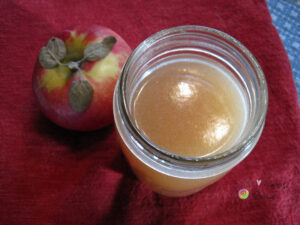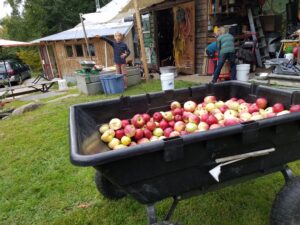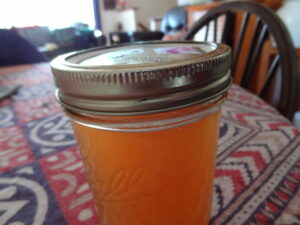Apple Cider Kefir: Probiotic-Rich Recipe 🍎
Tara Carpenter, NC.
Specialized in therapeutic nutrition for people regaining natural gut microbiome after yeast, bacterial, viral infections and people healing with Body Ecology Diet.

Originally published on September 19, 2019.
Here in Vermont, we press apples into cider into mid to late September; a fun activity for kids to participate in the workload at home. This year was especially abundant, so they pressed a good 2 hours before coming in the house with sticky, fresh-pressed apple cider! I turned a few half-gallons into apple cider vinegar for the year ahead and froze a bunch to pull out for this recipe for Apple Cider Kefir.

This kefir is made simply with only apple cider and kefir starter*; a sweet ‘n sour concoction that fizzes like champagne and is pure effervescence! What I am most on about is that inside this beverage lives an abundance of potent probiotic strains that implant themselves into digestive canal of your body, from your mouth down they go to burrow in to the soft tissue lining and keep inflammation down and healing up. More benefits here.
Friendly flora act as a digestive aid to keep the gut in good shape.
Looking for an easy, affordable way to get probiotic dose? This is a great recipe to make. Especially if you have bloating, constipation, or Candida.

A refreshing glass of juice kefir is a wonderful way to kick start your day and keep healthy internal gut bugs in balance.
Many people on Body Ecology Diet (B.E.D.) ask if this is stage 1-friendly. Personally, I stayed with young coconut kefir and unsalted cultured vegetables for the first few months on the diet before introducing other types of probiotic food such as juice kefir, milk kefir and hemp milk kefir.
Go with what has YOU feeling great 🙂

Juice Kefir Recipe
2 cups apple cider (or R.W. Knudsen juice)
1 packet of Body Ecology kefir starter*
1 pint-sized Mason jar with a well-fitted sealing lid
- Sterilize jar and lid by immersing in boiling water OR spray down with food-grade hydrogen peroxide.
- Warm cider in small pot on stove until 92 degrees (skin temperature will show as a drop on your wrist will not feel like anything at all).
- Pour warm cider into the jar.
- Mix foil packet of kefir starter in cider; put clean lid on.
- Ferment at 72-75 degrees F for 18-24 hrs. until slightly fizzy and pressure has built up under lid (our incubator kit is designed to keep jars at a consistent temperature).
- Store in fridge, up to 2-4 days depending how sweet the cider is (see below for instructions to store longer).
- Enjoy up to 1/2 cup in morning when stomach is empty.
- Feed kefir every couple days with fresh juice and/or scoop of EcoBloom to give probiotics living in the kefir natural sugar to feed on so they stay alive ‘n thrive (rather than turn kefir into alcohol).

Short Shelf Life
If you put a jar of milk kefir in fridge, it’ll be fine for weeks without needing to do anything special because contains fat and protein which slow down how fast probiotics break things down. Same for unsalted cultured vegetables, which contain fiber that probiotics chew on in their semi-dormant state. These probiotic foods are stable and don’t need much attention once made as fiber/fat/protein buffer rate at which probiotic organisms grow in population.
The above is not true for apple cider kefir because fruit juice contains no fat or protein, so if you put live probiotics into a jar of juice, expect a fast turn around. This is a thriving product that needs more attention! The probiotics you add to juice will convert the fruit sugar into lactic acid. Every day you have cider kefir, then drink some and add in fresh cider to feed those probiotics every day or two with fresh juice.
If you neglect this step, you get an over-kefired product that tastes alcoholic and far from pleasant. This is the last thing you want to drink; especially if your body is ridden with yeast overgrowth.

Starting a New Batch: Transfer Instructions
To keep cider kefir around longer than 2-3 days, feed it. Here’s how I do that for my family of 4 …. each morning when I pour us a glass of juice kefir, I leave a small amount in jar (about 3 Tbsp) then I top jar with fresh cider and leave on counter a couple hours before putting back in fridge.
Say you are the only person in your family drinking juice kefir then you might want to replenish with the same amount of fresh unkefired juice and put it back into fridge because there is more juice kefir then fresh juice, so it’s going to kefir even in the fridge. Does that make sense? This is my system, you might come up with a different one. Keep in mind, I only keep a pint of juice kefir going at once because that’s what I find manageable.
Below is another method of transfer that’s a lot like keeping a sourdough starter going. You feed it occasionally. Though juice kefir can’t be kept indefinitely like sourdough starter, you can extend its shelf life for weeks by feeding it.
Here’s how…
- Use some of initial batch of juice kefir, a.k.a. “starter batch”.
- Before you drink all the starter batch, make a new batch, called “transfer”. Best done within 3 days of making initial batch. Do this by combining fresh, warm juice with transfer amount (see below) of each previous batch.
- Follow above directions as normal ~ will take less than 12 hours to kefir subsequent batches.
- You can repeat a transfer 5-7 times, before you will need to start a fresh batch with a new starter packet.
Transfer Amount
If you want…
- 1 pint juice kefir then add 3 Tbs. of starter batch, top with juice.
- 1 quart juice kefir then add 1/4 cup of starter batch, top with juice.
- 1/2 gallon juice kefir then add 2/3 cup of starter batch, top with juice.
And on you go …. I find juice kefir has a hard time “catching” if I go past 5-7 transfers. You’ll learn as you go by smell and taste. My experience is the better I care for those first initial batches (#1, #2, etc.) the more vitality I squeeze out of them.

*Body Ecology kefir starter contains strong strains of probiotics that do not get destroyed by antibiotics, fluoride, stomach acid, or chlorinated water; successfully reaching your gut in an intact state to make home in the intestines where they work to keep us balanced and healthy. Lactobacillus bacteria and strains of beneficial yeast in this starter are sturdy enough to make transfers possible. More bang for your buck!
Reference
Gates, D. (2010). The Body Ecology Diet. Bogart, GA: B.E.D. Publications

Traditional Milk Kefir
Young Green Coconut Kefir
Therapeutic Nutritional Support
Disclaimer: Content on this site in the form of opinions, ideas, recipes, and lifestyle/dietary advice are provided for general information only; primarily educational in nature; and should not be treated as a substitute for your doctor’s medical advice or another health professional that you, the reader, may require for any cause whatsoever, now or in future.
May all bellies be happy!

